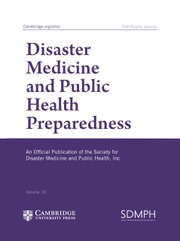Article contents
Comparison of 4 Different Threshold Values of Shock Index in Predicting Mortality of COVID-19 Patients
Published online by Cambridge University Press: 23 December 2021
Abstract
The object of this study was to examine the accuracy in prehospital shock index (SI) for predicting intensive care unit (ICU) requirement and 30-d mortality among from coronavirus disease 2019 (COVID-19) patients transported to the hospital by ambulance.
All consecutive patients who were the age ≥18 y, transported to the emergency department (ED) by ambulance with a suspected or confirmed COVID-19 in the prehospital frame were included in the study. Four different cutoff points were compared (0.7, 0.8, 0.9, and 1.0) to examine the predictive performance of both the mortality and ICU requirement of the SI. The receiver operating characteristic (ROC) curve and the area under the curve (AUC) was used to evaluate each cut-off value discriminatory for predicting 30-d mortality and ICU admission.
The total of 364 patients was included in this study. The median age in the study population was 69 y (range, 55-80 y), of which 196 were men and 168 were women. AUC values for 30-d mortality outcome were calculated as 0.672, 0.674, 0.755, and 0.626, respectively, for threshold values of 0.7, 0.8, 0.9 and 1.0. ICU admission was more likely for the patients with prehospital SI > 0.9. Similarly, the mortality rate was higher in patients with prehospital SI > 0.9.
Early triage of COVID-19 patients will ensure efficient use of health-care resources. The SI could be a helpful, fast, and powerful tool for predicting mortality status and ICU requirements of adult COVID-19 patients. It was concluded that the most useful threshold value for the shock index in predicting the prognosis of COVID-19 patients is 0.9.
Information
- Type
- Original Research
- Information
- Copyright
- © The Author(s), 2021. Published by Cambridge University Press on behalf of Society for Disaster Medicine and Public Health, Inc.
References
- 8
- Cited by

